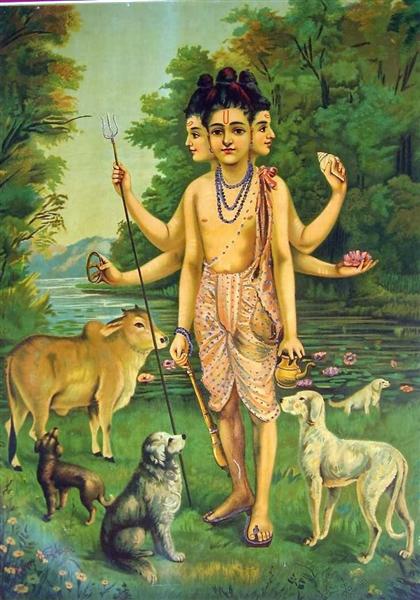Description
The painting "Dattatreya - 1910" of the distinguished artist Ravi Varma is a sublime manifestation of the mastery and sensitivity that characterize his work. Ravi Varma, one of the most venerated painters in India, is known for its ability to integrate the Indian pictorial tradition with Western techniques, achieving a symbiosis that enriches both worlds.
In "Dattatreya - 1910", Ravi Varma Raja chooses to represent Dattatreya, a venerated deity in Hinduism, known as a conglomerate of the Divine Trinity of Brahma, Vishnu and Shiva. Painting is a symbol of the spiritual triad and its union, an omnipresent theme in Indian iconography. Dattatreya appears in the center of the composition, with three heads that represent the three deities and with four arms, carrying symbolic attributes.
Color domain is remarkable; Varma uses soft and warm tones that invite contemplation. The subtle transitions between the colors suggest a dawn or sunset, transporting the viewer to a meditative state. Golden and brown tones predominate in painting, creating an earthly and heavenly sensation at the same time. The palette used by Ravi Varma resonates with the spirituality that surrounds the central character and reinforces the transcendental atmosphere of the painting.
The composition follows a classic scheme, with Dattatreya located in the center, directly attracting the look of the observer. The arrangement of the elements is symmetrical and harmonious, a reflection of the stability and balance that Dattatreya symbolizes in Hindu mythology. Around the central figure, there is a natural background with trees and mountains that suggest that divinity is in communion with nature, an appellant aspect in many varmous works.
Western techniques learned by Ravi Varma, such as the use of chiaroscuro and perspective, are evident in this work. These techniques give the volume and realism figure, causing Dattatreya to emerge from the canvas with an almost tangible presence. Varma, however, is not limited to the mere imitation of Western styles, but merges them with traditional Indian symbolism and iconography masterfully.
An aspect that should not be overlooked is the attention to detail in the clothing and jewels of Dattatreya, which denote a deep knowledge of the traditions and the Indian folklore. Each part of the outfit, each accessory, has a meaning and is represented with meticulous precision.
The work "Dattatreya - 1910" is inscribed within the broader context of Indian romanticism of the nineteenth and early twentieth centuries, where artists such as Ravi Varma sought to recover and revitalize Indian cultural heritage, while adapting to global influences. Varma, in particular, is known for his representations of Hindu gods and goddesses, epic subjects and historical characters with a sensitivity that transcends time.
In conclusion, "Dattatreya - 1910" is an expression of the skill and artistic vision of Ravi Varma. The work not only captivates its aesthetic beauty, but also invites a deep reflection on spirituality and tradition. It is a painting that perpetuates the cultural wealth of India and serves as a bridge between the Indian classic art and the modern techniques of its time.
KUADROS ©, a famous paint on your wall.
Hand-made oil painting reproductions, with the quality of professional artists and the distinctive seal of KUADROS ©.
Art reproduction service with satisfaction guarantee. If you are not completely satisfied with the replica of your painting, we refund your money 100%.

